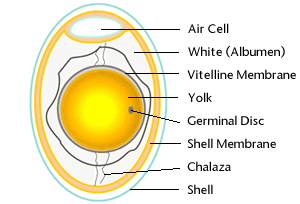 |
| Air Cell |
| The air cell at the blunt end of the egg is formed when the egg cools after it is laid, as the membrane pulls away from the outer membranes. Fresh eggs have smaller air cells. |
| White (Albumen) |
| The egg white or albumen is made up of 88% water, 9% protein and some minerals*. It consist of two layers - thin and thick albumen. Thin albumen surrounds the thick albumen. Thick albumen immediately surrounds the yolk acting as a cushion for the yolk. The chalaza is found in the thick egg white attached to the end of the yolk. |
| Vitelline Membrane |
| The vitelline membrane is an elastic membrane that holds the egg yolk. |
| Yolk |
| The yolk is made up of 51% water, 16% protein, 30.5% fat and some minerals*. The color of the yolk ranges from light yellow to deep orange depending on the hen's feed and does not reflect on the nutritional value of the egg. |
| Germinal Disc |
| Germinal disc is the entry for fertilization of the egg. It can be seen on the surface of the yolk. |
| Shell Membranes |
| There are two shell membranes. One encloses the contents of the egg, and the other is attached to the shell. These membranes help prevent bacteria from penetrating into the egg. |
| Chalaza |
| The chalaza is a pair of spiral bands which anchor the yolk in the center of the thick albumen. |
| Shell |
| The shell consists of 98% calcium, and 2% phosphorus and magnesium.* This layer protects the egg against bacteria. The surface of the egg is covered with small pores which allows gases and water vapour to pass though the shell. |
| Bloom |
Freshly laid eggs are covered with a thin, transparent cuticle called the bloom which covers the pores, restricting flow of water and gasses through the shell. Over time, the bloom breaks down and the egg will be more susceptible to bacteria and odours.
*Source: Australian Egg Industry Association |